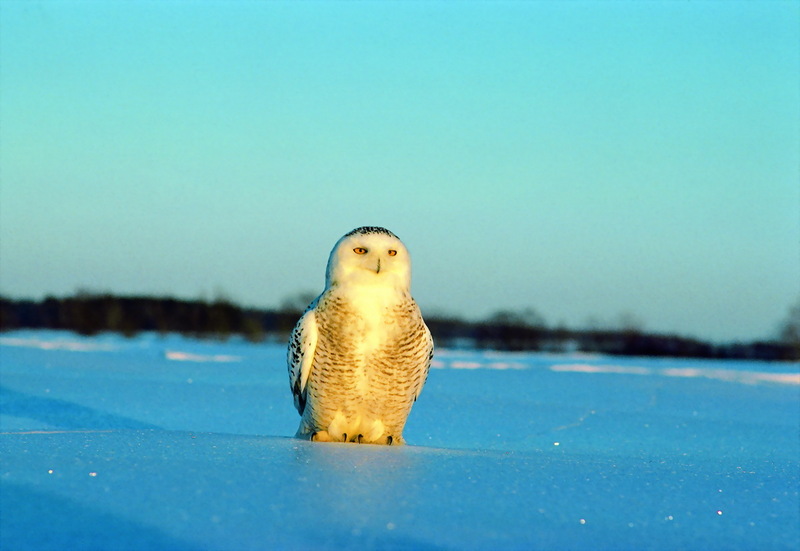Snowy Owl (Bubo scandiacus) - Wiki Snowy Owl
From Wikipedia, the free encyclopedia
[Photo] Snowy owl (Bubo scandiacus) in Canada. From the Quebec government website.
The Snowy Owl (Bubo scandiacus) is a large owl of the typical owl family Strigidae. It is also known in North America as the Arctic Owl or the Great White Owl. Until recently, it was regarded as the sole member of a distinct genus, as Nyctea scandiaca, but mtDNA cytochrome b sequence data (Olsen et al. 2002) shows that it is very closely related to the horned owls in the genus Bubo.
Description
This yellow-eyed white bird is easily recognizeable. It is 53-65 cm (20-26 inches) long with a 125-150 cm (50-60 in) wingspan. The adult male is virtually pure white, but females and young birds have some dark scalloping; the young are heavily barred, and dark spotting may even predominate. Its thick plumage, heavily-feathered feet, and coloration render the Snowy Owl well-adapted for life north of the Arctic Circle.
Snowy Owl calls are varied, but the alarm call is a barking, almost quacking krek-krek-krek-krek; the female also has a softer mewling pyee-pyee-pyee-pyee or prek-prek-prek. The song is a deep repeated gawh. They may also clap their beak in response to threats or annoyances. While called clapping, it is believed this sound may actually be a clicking of the tongue, not the bill.
Behavior
The Snowy Owl is typically found in the northern circumpolar region, where it makes its summer home north of latitude 60 degrees north. However, it is a particularly nomadic bird, and because population fluctuations in its prey species can force it to relocate, it has been known to breed at more southerly latitudes. During the last ice age, there was an Central European paleosubspecies of this bird, Bubo scandiacus gallicus, but subspecies are not recognized among the living population.
This species of owl nests on the ground, building a scrape on top of a mound or boulder. A site with good visibility, ready access to hunting areas, and a lack of snow is chosen. Gravel bars and abandoned eagle nests may be used. Breeding occurs in May, and depending on the amount of prey available, clutch sizes range from 5 to 14 eggs, which are laid singly, approximately every other day over the course of several days. Hatching takes place approximately five weeks after laying, and the pure white young are cared for by both parents.
Range
Snowy Owls winter south through Canada and northernmost Eurasia, with irruptions occurring further south in some years. They have been reported as far south as Texas, Georgia, the American Gulf states, southern Russia, northern China and even the Caribbean. Between 1967 and 1975, Snowy Owls bred on the remote island of Fetlar in the Shetland Isles north of Scotland, UK. Females summered as recently as 1993, but their status in the British Isles is now that of a rare winter visitor to Shetland, the Outer Hebrides and the Cairngorms.
Diet
This powerful bird relies primarily on lemmings and other rodents for food, but at times when these prey are not available, or during the ptarmigan nesting period, they may switch to ptarmigan young. As opportunistic hunters, they feed on a wide variety of small mammals and birds, and will take advantage of larger prey, frequently following traplines to find food. Nesting birds require roughly two lemmings per day, and a family may eat up to 1500 lemmings before the young birds set off to fend for themselves.
Human interactions
Due to their beauty, Snowy Owls are kept in captivity by wildlife centers, zoological gardens and by serious hobbyists. They are known to be sensitive to disease, stress and heat, frequently perishing during attempts to train a wild owl during the summer. These owls are not suitable for beginning raptor keepers.
http://en.wikipedia.org/wiki/Snowy_Owl
| The text in this page is based on the copyrighted Wikipedia article shown in above URL. It is used under the GNU Free Documentation License. You may redistribute it, verbatim or modified, providing that you comply with the terms of the GFDL. |
